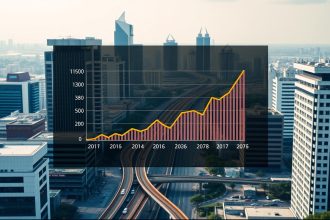According to the latest data on steel production in 2022, China maintained its position as the world’s leading steel producer. The statistics, measured in million tonnes, highlight China’s significant dominance in the global steel industry. Here is a breakdown of the steel production figures for various countries:
🇨🇳 China: 1013.0 million tonnes
China continued to lead the world in steel production, surpassing the 1 billion tonne mark. The country’s robust manufacturing sector, infrastructure development, and construction projects contributed to its remarkable output.
🇮🇳 India: 124.8 million tonnes
India solidified its position as the second-largest steel producer globally. The country’s growing industrialization and infrastructure projects fueled the expansion of its steel sector.
🇯🇵 Japan: 89.2 million tonnes
As a major player in the global steel industry, Japan ranked third in terms of steel production. The country’s advanced technological capabilities and automotive industry supported its steady output.
🇺🇸 United States: 80.5 million tonnes
The United States maintained its position as the fourth-largest steel producer. Its manufacturing sector, construction activities, and demand from the automotive industry contributed to its steel production levels.
🇷🇺 Russia: 71.5 million tonnes
Russia remained a significant player in the global steel market. The country’s vast mineral resources, particularly iron ore, supported its steel production.
🇰🇷 South Korea: 65.9 million tonnes
South Korea secured its position as one of the top steel-producing nations. The country’s thriving shipbuilding and automobile industries played a pivotal role in its steel production.
🇩🇪 Germany: 36.8 million tonnes
Germany maintained its status as a prominent steel producer in Europe. The country’s strong industrial base and machinery manufacturing industry contributed to its steel output.
🇹🇷 Turkey: 35.1 million tonnes
Turkey ranked among the top steel producers, driven by its expanding construction sector and investments in infrastructure projects.
🇧🇷 Brazil: 34.0 million tonnes
Brazil, a major player in the steel industry, continued to bolster its production. The country’s abundant iron ore reserves and strong demand from domestic and international markets supported its steel sector.
🇮🇷 Iran: 30.6 million tonnes
Iran remained a significant steel producer, benefiting from its rich natural resources and investments in steel manufacturing infrastructure.
🇮🇹 Italy: 21.6 million tonnes
Italy maintained its position as one of the leading steel producers in Europe. The country’s strong manufacturing sector, including the automotive and machinery industries, contributed to its steel output.
🇹🇼 Taiwan: 20.7 million tonnes
Taiwan continued to be a notable steel producer in the Asia-Pacific region. The country’s advanced technology and electronics industries played a vital role in its steel production.
🇻🇳 Vietnam: 20.0 million tonnes
Vietnam’s steel production witnessed significant growth, driven by infrastructure development and increased demand from various sectors, including construction and manufacturing.
🇲🇽 Mexico: 18.2 million tonnes
Mexico remained a prominent steel producer in the Americas, supported by its manufacturing sector, construction activities, and automotive industry.
🇮🇩 Indonesia: 15.6 million tonnes
Indonesia’s steel production showed steady growth, fueled by infrastructure development, urbanization, and industrial expansion.
🌎 Rest of the World: 201.0 million tonnes
The rest of the world collectively contributed a substantial amount to global steel production. Various countries, including those in Europe, Africa, and the Middle East, played a significant role in meeting global steel demand.
These figures highlight the dynamic nature of the global steel industry, with China maintaining its dominant position as the world’s largest steel producer. As countries strive for industrial growth and infrastructure development, the demand for steel remains strong, driving production across different regions.












